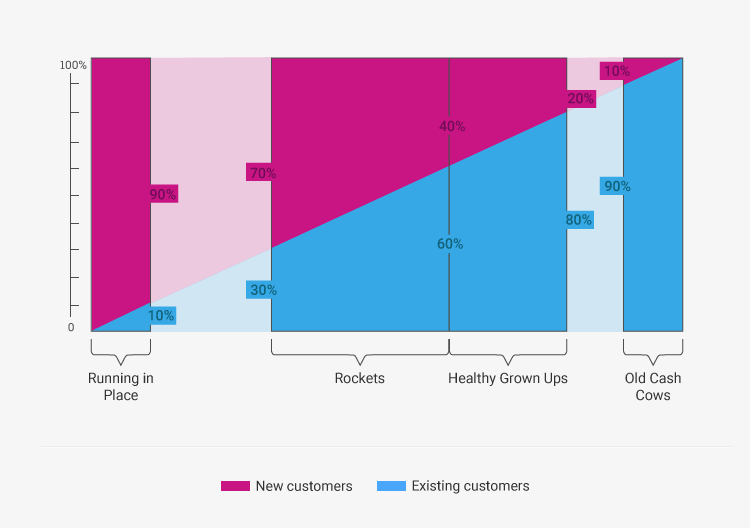
AI and the Retail Marketer’s Future
How AI transforms strategy and processes, driving the adoption of Positionless Marketing
Exclusive Forrester Report on AI in Marketing

Online retailers must focus on growing their customer base through new user acquisition, while simultaneously keeping their existing customers happy and engaged. Investment, however, is a zero-sum game, and the reality of most businesses is that investment in acquiring new customers comes at the expense of nurturing relationships with existing ones, and vice versa. Herein lies the great importance of optimizing the company’s new-to-existing customer revenue ratio, what we call the “customer revenue mix.”
Innumerable articles and blogs have been published on the topic of acquisition vs. retention. The consensus seems to be that acquiring new customers is more expensive than retaining existing ones, and that up/cross-selling to your existing customer base is easier than selling to new customers. But all agree that neither group can be ignored and that in order to grow successfully, online retailers need both new and existing customers.
The optimal customer revenue mix depends in large part on the retailer’s growth stage. But some questions still beg to be asked: What is the ideal revenue mix between new and existing customers? Is there a correlation between the customer revenue mix and a company’s success? And which customer revenue mix benchmarks should companies consider as they evolve and grow?
More from Optimove on customer modeling:
Behavior-based Customer Segmentation for More Effective Retail MarketingHow to Perform Customer Survival Analysis
How to Treat Every Customer Campaign as a Marketing Experiment
We turned to Optimove’s customer database, covering more than 180 brands in a variety of growth stages, to examine the possible correlation between a company’s growth and success rates and its new: existing customer ratio. We limited the research to companies more than five years old and with more than $10M of annual revenue. We eliminated the impact of mergers and acquisitions, because they commonly create outliers in terms of growth and new: existing customer ratios.
To assess each company’s state of affairs, we used a combination of top-line factors that included year-over-year growth during the past three years and five-year CAGR (Compounded Annual Growth Rate). We then identified clusters of companies with a similar customer revenue mix that also share core attributes such as years in business, growth stage, conversion rates, retention rates, churn rates and changes in Customer Lifetime Value over time.
Our research revealed four groups of companies, which we named Running-in-Place, Rockets, Healthy Grown-Ups and Old Cash Cows. A look at the characteristics they have in common offers insights into the preferred customer revenue mix and the dynamics through which a healthy customer revenue mix promotes growth – or hinders it. The following chart shows the new: existing customer revenue mix for each of these four groups.

These companies have experienced stagnated growth or declining revenues for the last three to five years, with a five-year CAGR lower than 2% and a customer revenue mix skewed dramatically towards new customers. Companies with great marketing that continually acquire new customers are expected be able to grow quite quickly. However, our data shows that when 90% of a company’s revenue comes from new customers, it is a signal that the company is not successful in turning those customers into active, valuable customers. These companies experience churn rates 100% higher than our sample average. Therefore, while continuously working hard on acquiring new customers, the companies in this group stand still in terms of growth and do not ramp up.
This can usually be attributed to one of two things: either the company is not acquiring the right kind of new customers, those less suited to its offerings, or the company is not doing an adequate job of converting those new recruits into ongoing, active customers. In many cases it is both. By investing in retaining even a small portion of new customers, Running-in-Place companies will slowly but surely build a stronger core customer base that can help turn them into Rockets.
These are companies with annual growth of more than 50% for the last five years and a five-year CAGR of over 100%. These companies are usually relatively early in their growth cycle and have been around for less than seven years. While Rockets have a customer revenue mix that tilts towards new customers, all the Rockets in our sample derive at least 30% of their annual revenues from existing customers, and 80% of them derive about 50% of their revenues from existing customers. Rockets in our sample managed to retain their acquired customers and experience churn rates 50% lower than the sample’s average. However, the reality is that startups that don’t shift their mix towards existing customers and improve churn rates don’t manage to become Rockets, and remain at the Running-in-Place stage, experiencing low or negative growth after a short ramp-up period.
These are companies with a five-year CAGR between 20% and 60% and that have been around for more than seven years. These companies usually possess significant market share in their respective industries and have managed to continually acquire new customers while keeping retention rates high. In our sample, the typical Healthy Grown-Ups derive 60% to 80% of their revenue from existing customers, and 70% of them had over 70% of revenue coming from existing customers.
The success of these companies is attributed to their low churn rates and high “new-to-active” customer conversion rates. The average churn rate in this segment was 60% lower than the sample churn rate average. When companies reach a significant volume of active users, the churn rate becomes a critical factor in maintaining growth, because customer churn rates can easily overtake new customer acquisition rates. These companies have also optimized their customer acquisition process and are bringing in the right kinds of customers, keeping “new-to-active” conversions well above their industry averages.
Like the Running-in-Place group, Old Cash Cows show stagnated growth or declining revenues over the past three to five years, with a five year CAGR equal or lower than 2%. However, they differ significantly in their customer revenue mix and cause of stagnation. The typical Old Cash Cow in our sample derives 90% or more of its revenue from existing customers. While on the surface this appears to indicate healthy, recurring revenue, the fact is that even the most loyal customers eventually churn or reduce their spend levels. While churn rates at these companies are usually lower than the sample’s average, an old customer base is risky: even if these companies are still making a lot of money, sooner or later they get the reputation (true or not) of being non-innovative or outdated. And with a limited number of new customers joining, the road to declining revenue may be short.
There are several typical new: existing customer revenue ratios that online retailers should be aware of as they grow their business, and these ratios depend heavily on the specific company’s growth phase. A new, growing company must remember to nurture its new customers, and bear in mind that driving 90% of revenue from new customers could be a red flag. Our research further suggests that for e-tailers, this can be an on-going concern even past the growth stage.
Many e-tailers cater to niche markets, where customers are prone to new-customer behavior even if they buy repeatedly because the frequency of engagement is inherently low. E-tailers should be aware of this predicament and try to encourage their existing customers to increase engagement by varying product lines within the niche and adding replenishable merchandise where possible.
On the other hand, mature, solid companies should constantly refresh their customer base and keep in mind that an “old customer base” that is responsible for more than 90% of revenues may predict a business slowdown. For e-tailers, this sometimes requires spinning out new brands to bring in new blood, especially if the original brand can no longer attract enough new customers. Rebranding offerings for new target audiences by rethinking key attributes that affect these audiences (i.e., transforming products into services, rethinking delivery, packaging and messaging, etc.) may blaze a path to the hearts of new audiences and new generations, creating a far healthier revenue mix in the process.

Finally, identifying the new: existing customer revenue mix is only the tip of the iceberg as far as a company’s business model is concerned. Two companies with the same revenue mix may tell very different stories and drive growth in very different ways. A quick example might be two companies that both derive 75% of revenue from existing customers. One might be acquiring many new customers and converting only a small portion of them to active and loyal customers, while the other may choose a more focused acquisition strategy, acquiring a smaller number of new customers, but turning a larger portion of them into loyal, long-time customers.
In the end, it’s up to each business to decide for itself how much investment to pour into new user acquisition versus nurturing customer relationships. The data we presented here can help them determine whether their business has a healthy mix of new versus existing customers, or if it needs to focus more on one segment than the other.
Exclusive Forrester Report on AI in Marketing
In this proprietary Forrester report, learn how global marketers use AI and Positionless Marketing to streamline workflows and increase relevance.


Pini co-founded Optimove in 2012 and has led the company, as its CEO, since its inception. With two decades of experience in analytics-driven customer marketing, business consulting and sales, he is the driving force behind Optimove. His passion for innovative and empowering technologies is what keeps Optimove ahead of the curve. He holds an MSc in Industrial Engineering and Management from Tel Aviv University.


